It’s part of a long-term, calculated effort to steal the nuclear export market from the United States.
From the 1960s through the 1990s, the United States had a booming nuclear export business. It financed and provided the technology for dozens of reactors around the world.
But the market has changed. And the two countries capable of massive government-to-government deals—Russia and China—have skillfully taken over.
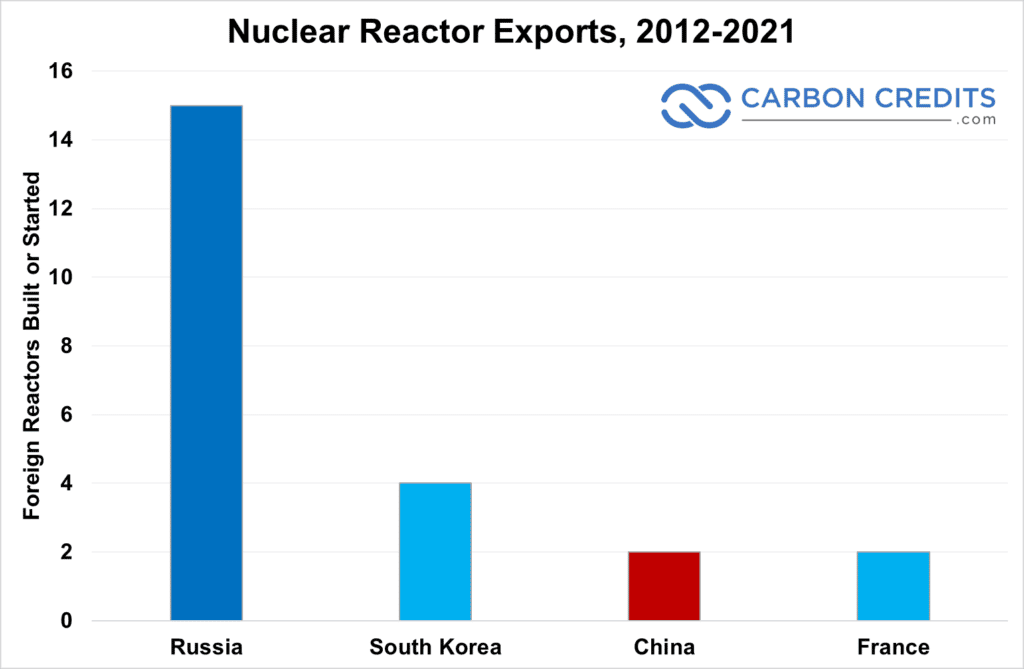
Though the nuclear export market has primarily been dominated by Russia in the past decade, China is starting to step up in a big way. 67 percent of all reactors to be completed worldwide by 2030 will be from one of the two countries.
Russia’s state-owned Rosatom has $133 billion in reactor export orders—more than fifty reactors in nineteen countries.
China is planning to export thirty of its Hualong One reactors by 2030, netting it $390 billion.
The U.S.? Zero.
Yet the U.S. Department of Commerce predicts the market will be worth between $500 billion and $740 billion over the next decade.
-
By 2050, the total nuclear energy export opportunity is expected to be as high as $1.9 trillion.
But for Russia and China, this isn’t just about money…
It’s about the century-long, unbreakable geopolitical bond created by building a nuclear plant in another country.
That’s why Russia is strategically exporting to surrounding countries.
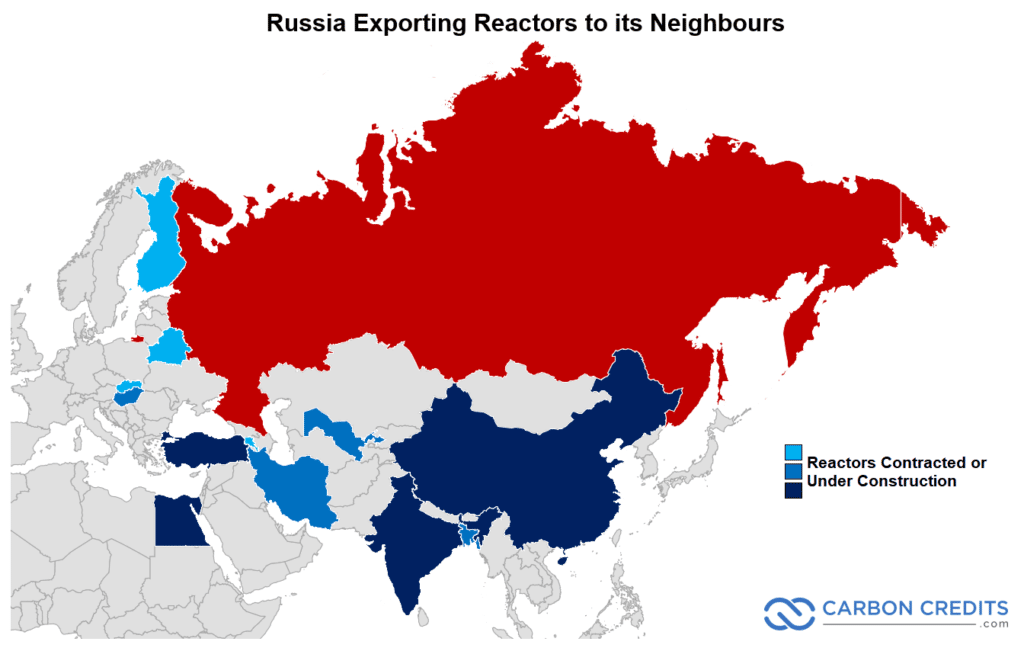
The death of American nuclear expertise and the associated exports is having other terrifying consequences, too:
- It’s losing its influence on foreign policy…
- It’s losing its access to nuclear-powered aircraft carriers and submarines…
- And it’s losing the ability to set safety standards for nuclear around the world.
In other words, the war for global nuclear reactor dominance has nothing to do with energy security.
It’s about national and global security.
And that’s something the entire U.S. government takes seriously.
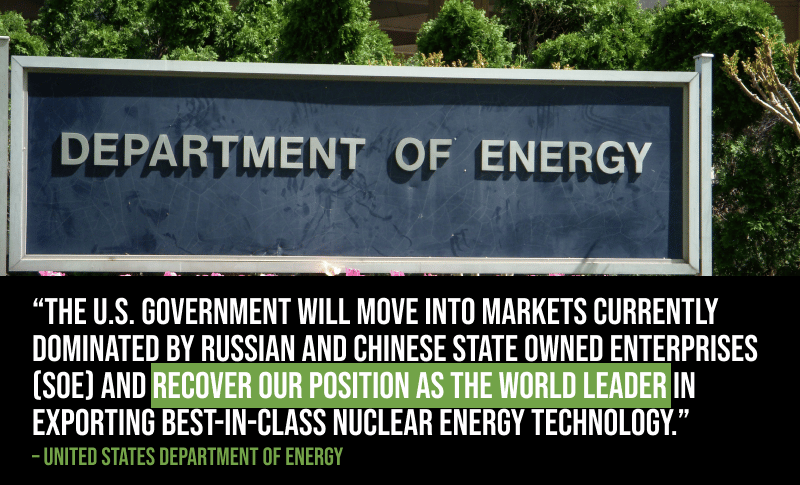
Nuclear Comes Home
Restoring the United States to a position of nuclear supremacy is one of the strongest bipartisan issues in the government today.
In fact, for the first time since Richard Nixon was president, both Democrats and Republicans have nuclear energy development in their platform.
And in the past four years, a flurry of laws have been quietly passed to support American and global nuclear energy development.
The legislation is intended to promote four primary areas:
- Existing Infrastructure
- Innovation
- Exports
- Fuel
Redeveloping American capacity for each of those will rapidly bring it back as a massive force on the world stage.
In April 2022, the Department of Energy implemented a $6 billion Civil Nuclear Credit Program to prevent reactors from shutting down prematurely.
It’s a deliberate move to force the U.S. to restore its nuclear infrastructure and rebuild its nuclear supply chain and workforce.
Four months later, the Inflation Reduction Act of 2022 (IRA) included several key provisions that made it clear that the United States is throwing its full weight behind nuclear energy.
There’s $150 million for the Office of Nuclear Energy to build out R&D.
And there’s $250 billion that can be used to update, repurpose, and revitalize nuclear infrastructure.
But the most significant is a first-ever production tax credit of up to $15 per MWh.
Not only does the credit make nuclear energy far more attractive to investors…
- It makes the cost of nuclear $33/kWh lower than offshore wind.
As the subsidies enjoyed by wind and solar are winding down, they’re ramping up for nuclear.
Next, Congress is turning toward developing the next generation of reactors—and the generation after that.
A Different Kind of 5G
Every year, new laws are granting significant funding to nuclear:
- Nuclear Energy Innovation Capabilities Act of 2017 – Authorized the creation of the National Reactor Innovation Center.
- Consolidated Appropriations Act of 2018 – More than $2.1 billion for Department of Energy and NRC nuclear programs, plus tax credits for new reactors.
- Nuclear Energy Innovation and Modernization Act of 2019 – Forced the NRC to streamline the licensing process for advanced reactors.
- Bipartisan Infrastructure Law of 2021 – Funding for the Advanced Reactor Demonstration Program.
These laws are all designed to stimulate billions in investment to “help domestic private industry demonstrate advanced nuclear reactors in the United States.”
They even created an “Office of Clean Energy Demonstrations” for that purpose.
The office has already funded an advanced nuclear research group that is building a direct competitor to China’s Fourth-Generation nuclear reactor.
All of this is the exact same template as the ‘60s: quietly fund lots of different types of experimental reactors to see what works.
Then, move full-bore ahead on the ones that do.
Bill Gates says that it’s the only way to optimize new nuclear technology and get “Green Premiums” down.
And it’s working.
More than fifty companies in the U.S. are working to bring advanced nuclear reactor technologies to market.
The first small modular reactor (SMR)—ostensibly the future of nuclear—is targeted to be operational in 2030.
The company running it expects a cost of $58/MWh (compared to ~$70MWh+ for natural gas). And that’s before the new production incentives.
These new reactors will be unlike anything any other country can offer:
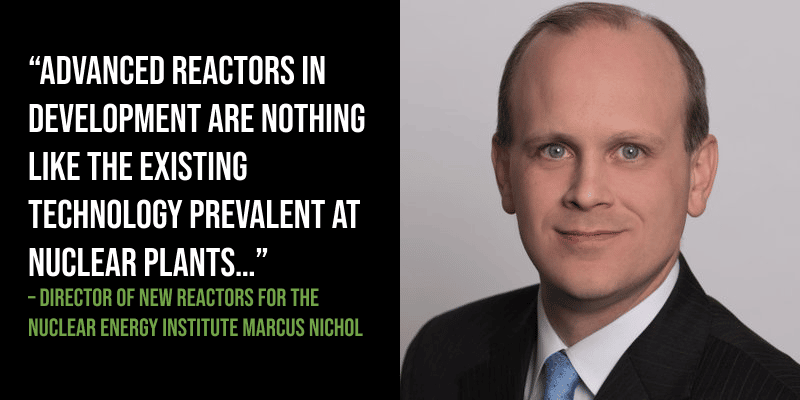
The Alternative Is Darkness
In April 2022, it was time for step three: financing exports.
You see, the most unassailable edge that China and Russia have isn’t nuclear technology.
It’s state money.
China knows how powerful it can be to force a country into debt.
When the U.S. exported four AP1000 reactors to China—the only U.S. reactor export since 2000—it offered $5 billion in financial assistance. China refused.
And China doesn’t just extend debt financing at favorable terms; it actively takes equity investment in international nuclear projects.
- Eventually, China will be able to fund global nuclear solely from its profits from offshore nuclear energy… enabling it to offer better financing terms than any other country in the world.
In addition to financing, Russia offers turnkey nuclear plant packages—construction, training, and even operations.
It’s a proposition that the United States is completely unequipped to match.
And it’s why, in early 2022, two senators brought back a secret U.S. weapon in the bipartisan International Nuclear Energy Act.
The Act establishes an Executive Office for Nuclear Energy Policy to develop a civil nuclear export strategy.
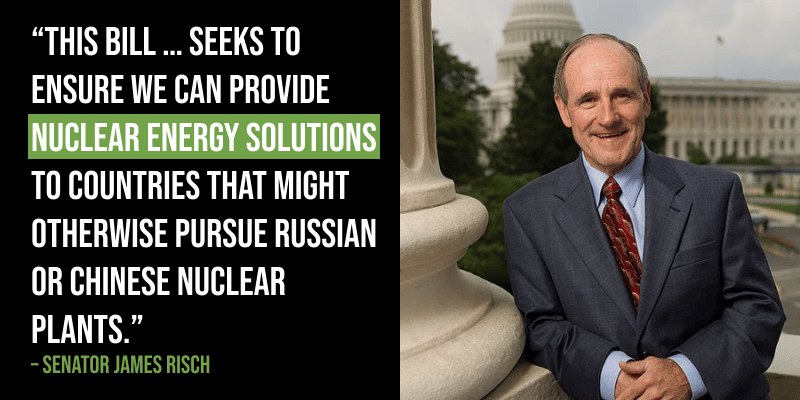
More importantly, it reopens the floodgates of U.S. nuclear financing.
The U.S. Export-Import Bank (EXIM) is designed to make exports financially available to other countries. Between 1955 and 1965, the bank enabled the U.S. to capture 100 percent of global nuclear exports.
During the ‘70s, EXIM gave out $4.2 billion in grants and $2 billion in guarantees for international nuclear (1975 dollars).
- In 1974 alone, the U.S. EXIM bank financed thirty-seven reactors in eleven countries.
And the bank has a sizeable war chest—$135 billion—completely available for spending.
EXIM has already begun funding nuclear exports.
It agreed to finance up to $7 billion for nuclear projects in Romania, including SMRs, after Romania cancelled a reactor order from Russia… and it has signed an agreement with Poland to provide financing for their nuclear program.
It’s all part of a master plan toward renewing American supremacy in nuclear energy, and ensuring no one else catches up.
Now that the infrastructure is being restored, innovation is being accelerated, and financing is available, it’s time for the United States to dominate the final chokepoint of nuclear:
Uranium.
